About Brain Aneurysms
Brain aneurysms are treatable. Identifying and understanding aneurysms before rupture is critical to help alleviate the pain many families encounter due to brain aneurysms. Information about brain aneurysms graciously provided by the Brain Aneurysm Foundation. For more information, please visit https://www.bafound.org/.
Brain Aneurysm Basics
What is a Brain Aneurysm?
A brain aneurysm is a weak, bulging area in an artery in the brain, analogous to a thin balloon or a weak spot on a tire’s inner tube. Because its walls may be weak and thin, an aneurysm is at risk of rupturing. If an aneurysm ruptures, blood spills into the space between the skull and the brain, a serious type of stroke known as a subarachnoid hemorrhage (SAH).
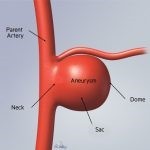  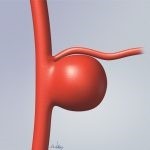 |
Types of Brain Aneurysms
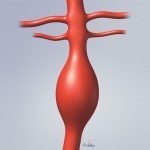 Saccular aneurysms, also called “berry” aneurysms because they look like berries, are the most common type of brain aneurysm. Saccular aneurysms have a “neck” that connects the aneurysm to its main (“parent”) artery and a larger, rounded area called the dome. These aneurysms bulge on only one side of the artery wall. A less common type is a fusiform aneurysm, in which the artery is widened on both sides. Fusiform aneurysms do not have a defined neck.
Saccular aneurysms, also called “berry” aneurysms because they look like berries, are the most common type of brain aneurysm. Saccular aneurysms have a “neck” that connects the aneurysm to its main (“parent”) artery and a larger, rounded area called the dome. These aneurysms bulge on only one side of the artery wall. A less common type is a fusiform aneurysm, in which the artery is widened on both sides. Fusiform aneurysms do not have a defined neck.
Understanding the Brain
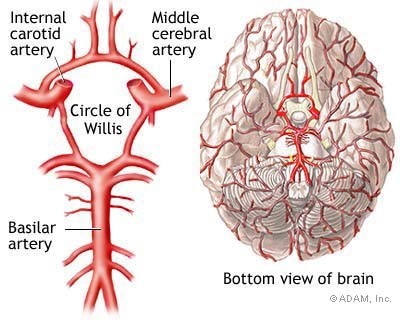
To understand aneurysms, it is helpful to understand the circulatory system of the brain. The heart pumps oxygen- and nutrient-laden blood to the brain, face, and scalp via two major sets of vessels: the internal carotid arteries and the vertebral arteries. The jugular and other veins bring blood out of the brain.
The carotid arteries run along the front of the neck – one on the left and one on the right. They are what you feel when you take your pulse just under your jaw. The carotid arteries split into external and internal arteries near the top of the neck.
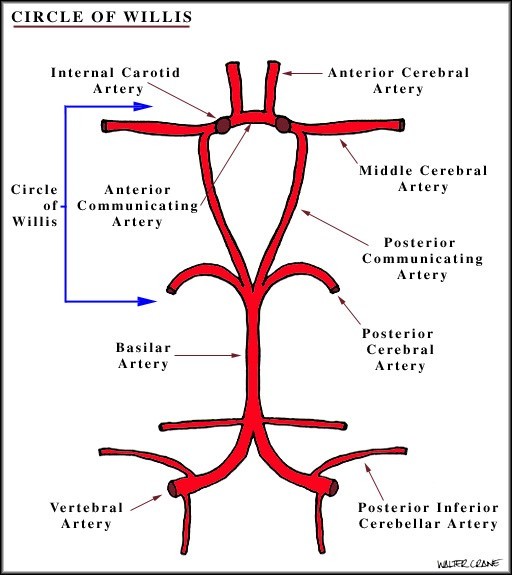 The external carotid arteries supply blood to the face and scalp. The internal carotid arteries supply blood to the front (anterior) three-fifths of cerebrum, except for parts of the temporal and occipital lobes.
The external carotid arteries supply blood to the face and scalp. The internal carotid arteries supply blood to the front (anterior) three-fifths of cerebrum, except for parts of the temporal and occipital lobes.
The vertebral arteries travel along the spinal column and cannot be felt from the outside. They join to form a single basilar artery (hence the name vertebrobasilar arteries) near the brain stem at the base of the skull. The arteries supply blood to the posterior two-fifths of the cerebrum, part of the cerebellum, and the brain stem.
Because the brain relies on only two sets of major arteries for its blood supply, it is very important that these arteries are healthy. These arteries that conduct blood to the brain — the internal-carotid and vertebral arteries — connect through the Circle of Willis, which loops around the brainstem at the base of the brain.
From this circle, other arteries — the anterior cerebral artery (ACA), the middle cerebral artery (MCA), and the posterior cerebral artery (PCA) — arise and travel to all parts of the brain. Brain aneurysms tend to occur at the junctions between the arteries that make up the Circle of Willis.
Warning Signs/ Symptoms
Ruptured Brain Aneurysms
Ruptured Brain Aneurysms usually cause bleeding into the space around the brain, called a subarachnoid hemorrhage (SAH), which can cause sudden symptoms. If you experience any of the following symptoms of a ruptured aneurysm, CALL 911. It is important to understand that not all of these symptoms may be present; the top few listed below are the most common.
Do not have a family member/friend take you in a private vehicle to the hospital. This is a high-stress situation that may require first responders to use lifesaving procedures in the emergency vehicle, and where time may be of the essence.
- Sudden and severe headache, often described as “the worst headache of my life.”
- Nausea/vomiting
- Stiff neck
- Blurred or double vision
- Sensitivity to light
- Seizure
- Drooping eyelid
- A dilated pupil
- Pain above and behind the eye
- Loss of consciousness
- Confusion
- Weakness and/or numbness
Unruptured Brain Aneurysms
Unruptured Brain Aneurysms usually have no symptoms. Typically, these aneurysms are small. Many unruptured aneurysms are found incidentally when tests are being done to screen for other conditions.
Rarely, unruptured aneurysms may become large and press on nerves in the brain, causing symptoms. If you experience these symptoms, seek prompt medical attention.
- Blurred or double vision
- A drooping eyelid
- A dilated pupil
- Pain above and behind one eye
- Weakness and/or numbness
Unruptured aneurysms rarely cause chronic headaches, however acute change in chronic headache pattern with respect to intensity or frequency would be a good reason to reach out to your health care provider.
Causes/ Risk Factors
Brain aneurysms develop silently. Some people may have inherited a tendency for weak blood vessels, which may lead to the development of aneurysms. Aneurysms in children are rare, and most aneurysms probably develop as a result of wear and tear on the arteries throughout a person’s lifetime. Occasionally, severe head trauma or infection may lead to the development of an aneurysm.
There are a number of risk factors that contribute to the formation of aneurysms, listed below. Two of the most significant are, fortunately, ones that can be controlled: cigarette smoking and high blood pressure (hypertension).
- Smoking
- High blood pressure (hypertension)
- Strong family history of brain aneurysms (familial aneurysms)
- Age (over 40)
- Gender: women have an increased risk of aneurysms
- Race: people of color have an increased risk of ruptured aneurysms
- Other disorders: Ehlers-Danlos syndrome, autosomal dominant polycystic kidney disease, Marfan syndrome, and fibromuscular dysplasia
- Presence of an arteriovenous malformation (AVM)
- Congenital abnormality in the artery wall
- Drug use, particularly cocaine
- Excessive alcohol use
- Infection
- Severe head trauma
